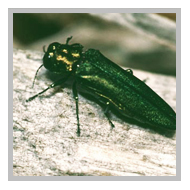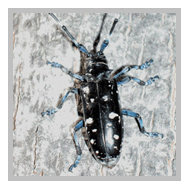


PESTS
 Emerald Ash Borer
Emerald Ash Borer
The Emerald Ash Borer is a shiny green beetle that kills living ash trees. The adults can be found on or near ash trees from early June to the end of august. The adults will feed along the margins of ash leaves and then deposit their eggs within the bark. The larvae stage causes the most damage to host trees. The larvae will feed between the sapwood and bark along the entire length of the tree trunk and branches. This cuts of the flow of nutrients which eventually kills the tree.
The beetle has now been found accross Southern Ontario and a quarantine zone by Ministerial Order has been instituted by the Canadian Food Inspection Agency (CFIA). To view a map of the Southern Ontario quarantine zone CFIA Link: EAB Quarantine Zone. The Ministerial Order for this quarantine zone outlines prohibitions and restrictions on the movement of firewood, nursery stock, mulch, wood chips, leaves, lumber, and logs from affected ash trees. Since the Emerald Ash Borer beetle can easily be spread by natural means limiting the movement of infested materials to within the quarantine zone prevents the spread of the EAB to un-infested areas in Ontario and Canada.
Click on the following city websites for more information on the Emerald Ash Borer in your region: The Greater Toronto Area The Town of Richmond Hill City of Mississauga or visit the Government of Canada EAB pages
 Asian Long-Horned Beetle
Asian Long-Horned Beetle
The Asian Long-Horned Beetle is a shiny jet black beetle with numerous white spots in their backs. Adults may be seen outdoors during the warmer parts of the day from summer to late autumn. They are usually seen feeding on tree leaves or branches before mating. Young larvae feed within the inner bark and sapwood and can cause the bark to become concave. Mature larvae will bore into the heartwood and coarse sawdust can be found in piles around the base of the tree or in branch unions. Adults will emerge through the wood in May by chewing round exit holes 6 to 12mm in diameter. Females will then chew oval ovipositor niches along any part of the tree about 10 mm wide and deposit a single egg. The tree reacts to this and can usually be seen as white frothy ooze on the bark. At this time the threat is thought to be contained
For more information on the Asian Long Horned Beetle go to http://www.inspection.gc.ca
WE CARE FOR YOUR OUTDOOR ENVIRONMENT.